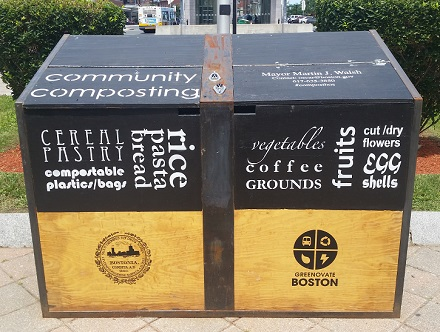
Susan Cascino has been Recycling Director for the City of Boston for the past 20 years. Most of her tenure has be with the Public Works Department, and in September she joined the Environment Department to work on waste reduction policy and zero waste planning. Read on for her explanation of Zero Waste and what it will take for Boston to achieve it.
The average American produces about 5lbs of trash per day, but that trash is just the tip of the iceberg. It is estimated that 71 tons of “upstream” waste is produced for every ton of municipal waste – so while the 5 pounds you are tossing every day might not seem that small, there is an entire “wasteberg” that brought that waste to you.
This is how we handle most of the stuff we touch in this country and around the world:
Take → Make → Waste.
Take raw materials from the Earth (oil, minerals, wood, etc.)
Make products. Distribute and consume them.
Waste what we don’t want anymore; bury or burn it.
This is called the linear economy, and it creates a lot of trash. Instead of using this discarded material in our economy, we mine, drill, and exact raw materials from the planet, which depletes our natural resources.
A circular economy imitates nature. In nature when something dies, it decomposes into the earth and provides nutrients for new growth. In a circular economy, products are made, sold, repaired or reused, then recycled and remanufactured into new products. No waste. All discarded materials are designed to become resources for others to use. Zero Waste also means eliminating the volume and toxicity of materials.
The principle of extended producer responsibility (which requires manufacturers to be responsible for the life cycle of their products) could also be a big driver in eliminating waste.
Here’s a helpful video from ecocycle.org that explains the connection between waste and climate change:
Zero Waste Municipal Leaders Summit
At the recent Zero Waste Municipal Leaders Summit, several experts on sustainable waste management provided insight on how Boston can achieve Zero Waste. Ruth Abbe, President of Zero Waste USA and Gary Liss, national recycling expert and founder of the National Recycling Coalition, provided a thorough explanations on what it looks like in the real world. Check out their presentations on Zero Waste for an excellent primer on the topic.
Zero Waste Strategies and Programs in the U.S., by Ruth Abbe
Introduction to Zero Waste, by Gary Liss
What does the City of Boston’s Climate Action Plan say about Zero Waste?
The 2014 Climate Action Plan is the City of Boston’s roadmap to help us reach our sustainability goals. It lays out the city’s existing data on waste and recycling and provides recommendations for next steps towards achieving Zero Waste. It shows that as of 2014, 76% of waste in Boston is collected as trash, 18% as recycling, and 6% as yard waste, compost, and special collections. Waste is sent to waste-to-energy facilities in Rochester or Haverhill, which provides energy to Boston’s electricity grid. The carbon emissions from that facility are included in the City’s emissions factors.
The Climate Action Plan states that by increasing recycling and reuse and diverting organics, the City can save money, create local jobs, and improve the environment. It lists more robust recycling policies, increased recycling in public places, composting programs, and garbage disposal installation as important factors in the move toward Zero Waste.
Pictured: One of the City of Boston’s Project Oscar bins, which allows community members to dispose of food waste in an environmentally-friendly way.


Recent Comments